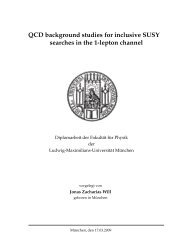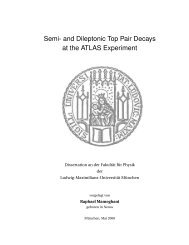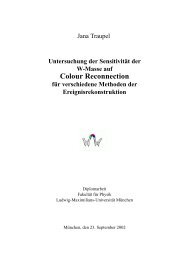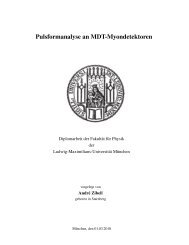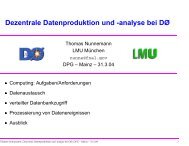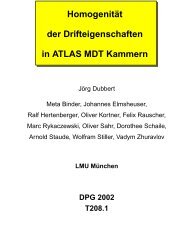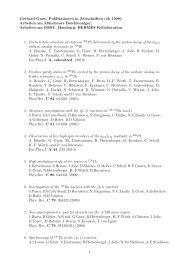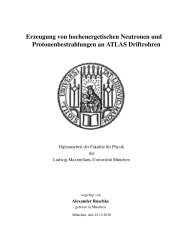development of micro-pattern gaseous detectors – gem - LMU
development of micro-pattern gaseous detectors – gem - LMU
development of micro-pattern gaseous detectors – gem - LMU
Create successful ePaper yourself
Turn your PDF publications into a flip-book with our unique Google optimized e-Paper software.
68 Chapter 6 Rise Time Studies<br />
2 ns<br />
> 10 ns<br />
Channel 1) Preamplifier response to 2ns pulse<br />
Channel 4) Scintillator pulse exiting differentiating circuit<br />
Figure 6.7: Response <strong>of</strong> the CASTA82<br />
preamplifier to a δ - shaped pulse <strong>of</strong> 2 ns<br />
width.<br />
for the CATSA82 preamplifier and<br />
2 ns<br />
10 ns<br />
Channel 1) Preamplifier response to 2ns pulse<br />
Channel 4) Scintillator pulse exiting differentiating circuit<br />
Figure 6.8: Response <strong>of</strong> the ELab preamplifier<br />
to a δ - shaped pulse <strong>of</strong> 2 ns width.<br />
τ = R · Ccoupl = 2.5Ω · 1.5 nF = 3.75 ns (6.3)<br />
regarding the ELab preamplifier. This estimation shows that the ELab preamplifiers rise time is<br />
negligible whereas the big coupling capacity <strong>of</strong> the CATSA82 preamplifier affects the rise time<br />
distribution significantly.<br />
In order to analyze the internal response time <strong>of</strong> the preamplifiers a δ-like pulse <strong>of</strong> 2 ns width and 10<br />
mV maximum pulse height is fed to the input. Since the trigger scintillators provide a frequent signal<br />
we can use this as a pulse generator. Combined with a discriminator and dual timer as already used<br />
in the conventional readout, see Ch. 3.4.1, the resulting box-shaped pulse is fed to a differentiating<br />
circuit. This setup supplies the narrow pulse which can be seen in Fig. 6.7 and Fig. 6.8 together with<br />
the response <strong>of</strong> the two preamplifiers. In this manner the internal rise time <strong>of</strong> the preamplifiers is<br />
determined to approximately 10 ns for both (see channels no. 1 in the corresponding Fig. 6.7 and<br />
6.8). The differentiating circuit transfers the scintillator pulse to a sharp negative pulse followed by a<br />
smaller overshoot that is repeated around 14 ns after the main pulse. The overshoot with 2 ns delay<br />
after the main pulse is not resolved by the preamplifiers. A plateau <strong>of</strong> the rise time is reached in 10 ns<br />
after the main pulse. The second small positive pulse <strong>of</strong> the test signal gives a second rise to the<br />
preamplifier response. The CATSA82 preamplifier shows a slightly faster response to the δ - shaped<br />
pulse than the ELab preamplifier whose amplitude is 50% higher, in contrast.<br />
This rise time is negligible in comparison to the 100 ns electron drift time and the 55 Fe induced rise<br />
times around 106 or 166 ns.<br />
6.2 Rise Time Dependence on Induction - Field<br />
In order to understand the signal rise time formation, data were taken in dependence <strong>of</strong> the E-field<br />
on the induction gap with the X-ray source as well as with cosmic ray muons. This is motivated by<br />
the estimate that the detectable pulse begins with the presence <strong>of</strong> the amplified charges at the lower



